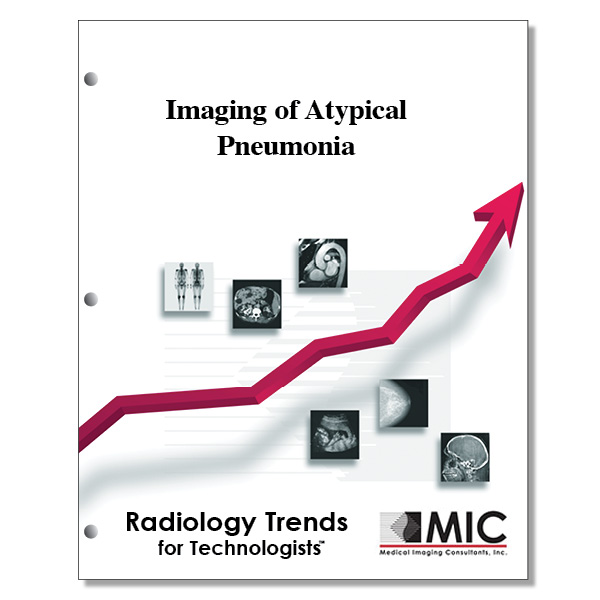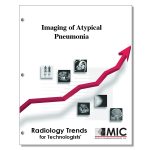

Imaging of Atypical Pneumonia
The terminology ‘atypical pneumonia’ is defined, the common microorganisms belonging to this group are identified (including the cause of the recent coronavirus pandemic), and the main clinical and imaging features are presented.
Course ID: Q00671 Category: Radiology Trends for Technologists Modalities: CT, Radiography2.75 |
Satisfaction Guarantee |
$29.00
- Targeted CE
- Outline
- Objectives
Targeted CE per ARRT’s Discipline, Category, and Subcategory classification:
Computed Tomography: 2.75
Procedures: 2.75
Neck and Chest: 2.75
Radiography: 2.75
Procedures: 2.75
Thorax and Abdomen Procedures: 2.75
Registered Radiologist Assistant: 2.75
Procedures: 2.75
Thoracic Section: 2.75
Outline
- Introduction
- What Does Atypical Pneumonia Mean
- Atypical Bacterial and Viral Pneumonias
- Nonzoonotic Atypical Bacterial Pneumonias
- Mycoplasma Pneumonia
- Legionella Pneumonia
- Chlamydia Pneumonia
- Zoonotic Atypical Bacterial Pneumonias
- Tularemia
- Psittacosis
- Q Fever
- Viral Pneumonias
- Influenza Pneumonia
- Avian Influenza (H5N1) Pneumonia
- Swine Influenza (H1N1) Pneumonia
- Parainfluenza Pneumonia
- RSV Pneumonia
- Adenovirus Pneumonia
- Human Metapneuovirus Pneumonia
- Coronaviruses
- Severe Acute Respiratory Distress Syndrome
- Middle East Respiratory Syndrome
- Coronavirus Disease 2019
- Imaging Atypical Pneumonias
- Conclusion
Objectives
Upon completion of this course, students will:
- be familiar with the percentage of community-acquired pneumonia cases linked to atypical bacteria
- identify three subgroups based on the clinical context in which the patient develops symptoms of infection
- be able to define community-acquired pneumonia (CAP)
- identify the common causes of CAP
- be familiar with the US and Japan guidelines for management of CAP
- be familiar with the zoonotic atypical pneumonias
- be familiar with the original radiological use of the term “atypical pneumonia”
- be familiar with who is credited with popularizing the term “atypical pneumonia”
- be familiar with the classification for the mode of transmission for atypical pneumonia
- identify the most common nonzoonotic causes of atypical bacterial pneumonia
- identify the most common zoonotic bacterial causes of atypical bacterial pneumonia
- be familiar with the lab findings associated with L pneumoniae
- be familiar with the viruses causing atypical pneumoniae
- identify a true viral zoonotic infection pathogen
- be familiar with the chest radiograph findings of patients infected with mycoplasma pneumonias
- identify the zoonotic reservoir for the pathogen F-tularensis
- recognize the laboratory findings for patients presenting with Q-fever
- identify the reservoir for patients presenting with the influenza virus
- be familiar with Q fever
- be familiar with the structure of the adenovirus
- be familiar with Legionnaires disease
- identify the reservoir for MERS-Cov
- be familiar with the structure of SARS-Cov 1 and MERS-CoV
- recognize the extrapulmonary manifestations commonly associated with Legionella spp
- recognize the clinical manifestation that is a distinguishing feature for patients presenting with chlamydia pneumonias
- be familiar with chest radiograph findings on patients presenting with C pneumoniae
- be familiar with chest radiograph findings on patients presenting with adenovirus
- identify the clinical suspicions related to zoonotic pneumonias
- be familiar with the CT findings for patients presenting with C psittaci
- be familiar with the workers historically exposed to psittacosis
- be familiar with the rarity of Q fever
- identify the viruses that most commonly affect humans
- be familiar with the types of influenza viruses
- identify the subtype of the influenza A virus responsible for avian influenza pneumonia
- identify the subtype of the novel-swine origin influenza A virus first reported in Mexico in 2009
- be familiar with the reservoir for adenoviruses
- be familiar with the COVID-19 virus
- be familiar with the CT findings on patients presenting with COVID-19
- be familiar with the role of CT for diagnosing patients with CAP
- recognize the role of CT during the initial stages of the COVID-19 pandemic
